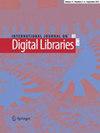Digital Libraries, Epigraphy and Paleography: Bring Records from the Distant Past to the Present: Part II
IF 1.7
Q2 INFORMATION SCIENCE & LIBRARY SCIENCE
引用次数: 0
Abstract
Abstract The two volumes of this Special Issue explore the intersections of digital libraries, epigraphy and paleography. Digital libraries research, practices and infrastructures have transformed the study of ancient inscriptions by providing organizing principles for collections building, defining interoperability requirements and developing innovative user tools and services. Yet linking collections and their contents to support advanced scholarly work in epigraphy and paleography tests the limits of current digital libraries applications. This is due, in part, to the magnitude and heterogeneity of works created over a time period of more than five millennia. The remarkable diversity ranges from the types of artifacts to the methods used in their production to the singularity of individual marks contained within them. Conversion of analogue collections to digital repositories is well underway—but most often not in a way that meets the basic requirements needed to support scholarly workflows. This is beginning to change as collections and content are being described more fully with rich annotations and metadata conforming to established standards. New use of imaging technologies and computational approaches are remediating damaged works and revealing text that has, over time, become illegible or hidden. Transcription of handwritten text to machine-readable form is still primarily a manual process, but research into automated transcription is moving forward. Progress in digital libraries research and practices coupled with collections development of ancient writtten works suggests that epigraphy and paleography will gain new prominence in the Academy.数字图书馆,铭文和古文字:从遥远的过去到现在带来的记录:第二部分
本特刊的两卷探讨了数字图书馆、金石学和古文字学的交叉点。数字图书馆的研究、实践和基础设施为馆藏建设提供了组织原则,定义了互操作性要求,并开发了创新的用户工具和服务,从而改变了古代碑文的研究。然而,将馆藏及其内容连接起来,以支持金石学和古文字学方面的高级学术工作,考验了当前数字图书馆应用的极限。这在一定程度上是由于在5000多年的时间里创作的作品的规模和多样性。从人工制品的类型到生产方法,再到其中包含的单个标记的独特性,都存在着显著的多样性。模拟馆藏到数字资源库的转换正在顺利进行,但大多数情况下,转换的方式不能满足支持学术工作流程所需的基本要求。随着集合和内容被更完整地描述为符合既定标准的丰富注释和元数据,这种情况开始发生变化。成像技术和计算方法的新应用正在修复受损的作品,并揭示随着时间的推移,变得难以辨认或隐藏的文本。将手写文本转录成机器可读的形式仍然主要是一个人工过程,但对自动转录的研究正在向前发展。数字图书馆研究和实践的进步,加上古代书面作品的收藏发展,表明金石学和古文字学将在学院中获得新的突出地位。
本文章由计算机程序翻译,如有差异,请以英文原文为准。
求助全文
约1分钟内获得全文
求助全文
来源期刊
CiteScore
4.30
自引率
6.70%
发文量
20
期刊介绍:
The International Journal on Digital Libraries (IJDL) examines the theory and practice of acquisition definition organization management preservation and dissemination of digital information via global networking. It covers all aspects of digital libraries (DLs) from large-scale heterogeneous data and information management & access to linking and connectivity to security privacy and policies to its application use and evaluation.The scope of IJDL includes but is not limited to: The FAIR principle and the digital libraries infrastructure Findable: Information access and retrieval; semantic search; data and information exploration; information navigation; smart indexing and searching; resource discovery Accessible: visualization and digital collections; user interfaces; interfaces for handicapped users; HCI and UX in DLs; Security and privacy in DLs; multimodal access Interoperable: metadata (definition management curation integration); syntactic and semantic interoperability; linked data Reusable: reproducibility; Open Science; sustainability profitability repeatability of research results; confidentiality and privacy issues in DLs Digital Library Architectures including heterogeneous and dynamic data management; data and repositories Acquisition of digital information: authoring environments for digital objects; digitization of traditional content Digital Archiving and Preservation Digital Preservation and curation Digital archiving Web Archiving Archiving and preservation Strategies AI for Digital Libraries Machine Learning for DLs Data Mining in DLs NLP for DLs Applications of Digital Libraries Digital Humanities Open Data and their reuse Scholarly DLs (incl. bibliometrics altmetrics) Epigraphy and Paleography Digital Museums Future trends in Digital Libraries Definition of DLs in a ubiquitous digital library world Datafication of digital collections Interaction and user experience (UX) in DLs Information visualization Collection understanding Privacy and security Multimodal user interfaces Accessibility (or "Access for users with disabilities") UX studies

 求助内容:
求助内容: 应助结果提醒方式:
应助结果提醒方式:


